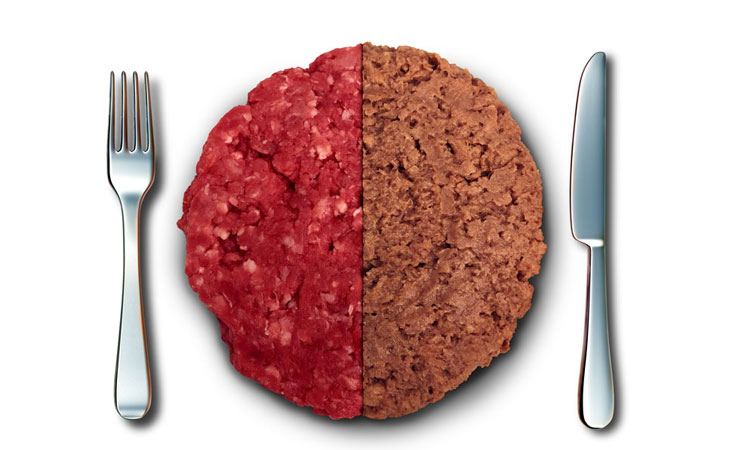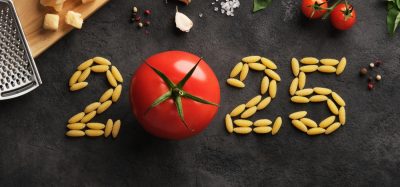Hybrid foods: the best of both worlds
- Like
- Digg
- Del
- Tumblr
- VKontakte
- Buffer
- Love This
- Odnoklassniki
- Meneame
- Blogger
- Amazon
- Yahoo Mail
- Gmail
- AOL
- Newsvine
- HackerNews
- Evernote
- MySpace
- Mail.ru
- Viadeo
- Line
- Comments
- Yummly
- SMS
- Viber
- Telegram
- Subscribe
- Skype
- Facebook Messenger
- Kakao
- LiveJournal
- Yammer
- Edgar
- Fintel
- Mix
- Instapaper
- Copy Link
Posted: 12 November 2020 | Simona Grasso | 1 comment
A study assessing consumer attitudes towards healthier meat products is looking to find some missing pieces of the puzzle in hybrid food offerings.


There is an increased interest in flexitarianism in the UK.1 In the market, a plethora of plant-based foods are being launched, while meat products are seeing a stagnation of sales.
According to Mintel, sales of bacon, sausages, burgers and coated poultry in the UK are forecast to increase by just one percent in the next five years.2 Volumes are expected to be held back by people reducing their consumption of processed meats and by the increased availability of meat-free substitutes.
Although there is an interest in lowering meat consumption, changing diet is not an easy task. To achieve a partial substitution of animal proteins in the diet with more sustainable plant proteins, long term dietary transitions should be established rather than short phases.3 Other studies have found that effective dietary changes can be created when new practices are not too different from consumers’ previous behaviour.4
Are hybrid foods the answer?
Hybrid foods (which blend animal ingredients with plant-based ones) could be a useful tool in diet change, helping to bridge the gap between the two markets. Such hybrids are most commonly represented by meat products, but recently have extended to also include dairy. For example, US‐based Live Real Farms has launched the first line of beverages that contain a blend of fresh milk and plant-based drinks.5
A study on 11,399 American adults in the US showed that five out of six people who became vegan or vegetarian eventually went back to eating meat.6 As such, the authors suggest we should encourage the majority of the population, rather than a smaller sample, to decrease their meat consumption, rather than give up meat completely.
Hybrid meat offerings could be considered as a sort of transition product; a food that still tastes, looks and has the texture of meat, but at the same time, has an increased content of plant-based ingredients. It can also be associated with positive health claims such as ‘one of your five a day’ or ‘a source of fibre’. These products might be suitable for those consumers who want to try something different and/or lower their meat consumption, but are not yet ready to move to meat-free alternatives.
Hybrid meat products have not been in the market for a long time. Aldi, the first retailer to launch a flexitarian burger made with beef and beans, did not have much success. It was attacked on social media by a vegan who claimed that “you either eat meat or you don’t” and resulted in negative press.7
There is an increased interest in flexitarianism in the UK.1 In the market, a plethora of plant-based foods are being launched, while meat products are seeing a stagnation of sales.
According to Mintel, sales of bacon, sausages, burgers and coated poultry in the UK are forecast to increase by just one percent in the next five years.2 Volumes are expected to be held back by people reducing their consumption of processed meats and by the increased availability of meat-free substitutes.
Although there is an interest in lowering meat consumption, changing diet is not an easy task. To achieve a partial substitution of animal proteins in the diet with more sustainable plant proteins, long term dietary transitions should be established rather than short phases.3 Other studies have found that effective dietary changes can be created when new practices are not too different from consumers’ previous behaviour.4
Are hybrid foods the answer?
Hybrid foods (which blend animal ingredients with plant-based ones) could be a useful tool in diet change, helping to bridge the gap between the two markets. Such hybrids are most commonly represented by meat products, but recently have extended to also include dairy. For example, US‐based Live Real Farms has launched the first line of beverages that contain a blend of fresh milk and plant-based drinks.5
A study on 11,399 American adults in the US showed that five out of six people who became vegan or vegetarian eventually went back to eating meat.6 As such, the authors suggest we should encourage the majority of the population, rather than a smaller sample, to decrease their meat consumption, rather than give up meat completely.
Hybrid meat offerings could be considered as a sort of transition product; a food that still tastes, looks and has the texture of meat, but at the same time, has an increased content of plant-based ingredients. It can also be associated with positive health claims such as ‘one of your five a day’ or ‘a source of fibre’. These products might be suitable for those consumers who want to try something different and/or lower their meat consumption, but are not yet ready to move to meat-free alternatives.
Hybrid meat products have not been in the market for a long time. Aldi, the first retailer to launch a flexitarian burger made with beef and beans, did not have much success. It was attacked on social media by a vegan who claimed that “you either eat meat or you don’t” and resulted in negative press.7
Coming to market
Luckily things have moved on since and other retailers have launched hybrid meat products with good results, including Waitrose, Tesco, Sainsbury’s and M&S. It is interesting to note that the packaging of these products and the messages they try to convey have changed a lot in a short period of time. Tesco, for example, claims that its hybrid range “helps make scratch cooking easier, removing the need to buy vegetables separately to make the base of popular dishes such as bolognese”, and it also “champions vegetables as flavour enhancers to provide sweetness to home cooked dishes”.8 While M&S went for the “one of your five a day” message in its Hidden Veggies range.9
Hybrid meat offerings could be considered as a sort of transition product
It is interesting to see that the market is changing and adapting rapidly to consumers’ needs. This is making meat companies a little bit more proactive and innovative, having seen the success of meat-free brands and how they appeal to the young markets.
Nevertheless, much remains unknown around hybrid meat products, so it is hard to say whether they will be here to stay or a fleeting trend. For example, it is not clear which meat product is preferred, which type of meat, which plant-based ingredients, or what ratio of meat to plant-based ingredients should be used. Other unknowns are pricing and market segmentation according to consumer demographics.
More information is needed
Our project, ‘Consumer attitudes towards healthier meat products’ is attempting to find an answer to these questions. This is funded by the European Institute of Innovation & Technology (EIT Food), with the project being led by the University of Reading. Other partners include ABP in the UK, the University of Aarhus in Denmark, and the Spanish National Research Council.
So far, we have carried out some co-creation focus groups in the three countries (UK, Spain and Denmark) on the concept of healthier meat product in general. Co-creation is an essential part in new product development, as it has been shown that developing new products with the support of consumers can have very positive results.10 In each country, we chose consumers with low and high processed meat consumption habits and selected participants of different ages to make sure we captured a broad spectrum.
In terms of co-developed ideas during the co-creation phase of the focus groups, beef was the base meat most frequently sought by participants for healthier meat products.
The addition of plant-based ingredients (ie, meat substitution and/or plant‐based flavours) and the reduction of salt and/or fat were the most common alterations suggested across countries.
Packaging, labelling and shelf life emerged as the main marketing factors consumers considered as most relevant when developing new healthier meat products. Specifically, these suggestions included recommendations about package size and aesthetics, animal welfare labels, and whether the new products should be sold fresh or frozen, among others.
We are now continuing with an online survey across the three countries to test the concept of hybrid meat products on a wide consumer population. We are carrying out the survey with 800 participants in each country and predict country‐specific differences, in terms of the preferred meat products or plant-based ingredients, to be identified.
After the survey, the plan is to choose the preferred hybrid meat in each country and manufacture it. We will assess the meat product from a quality and technological point of view and carry out sensory analysis with consumers to assess acceptability.
Covid-19 did impact our project, as our co-creation focus groups had to be carried out on Zoom. This took a bit of restructuring of our protocols, but overall, it worked really well. The sensory analysis is still in doubt, and we do not know if we will be able to carry it out on a traditional central location testing or if we need to try a ‘home-use’ test.
It is an interesting time for food research right now, to say the least. I believe that consumers will begin to better understand their power when it comes to making more sustainable food choices, and the food industry will need to be quick to catch up with their ever-changing needs. It might not be just a passing trend, after all.
About the author
Simona Grasso
Simona is a food scientist working as a Senior Research Fellow at the School of Agriculture, Policy and Development based at the University of Reading. She is leading the EIT Food project, Consumer attitudes towards healthier meat products.
References
- Mintel 2017. Executive summary. Meat-free Foods – UK – September 2018.
- Mintel 2019. Processed Poultry and Red Meat Main Meal Components – UK – November 2019 https://reports.mintel.com/display/921194/
- Hoek, A. C., Elzerman, J. E., Hageman, R., Kok, F. J., Luning, P. A., & de Graaf, C. (2013). Are meat substitutes liked better over time? A repeated in-home use test with meat substitutes or meat in meals. Food Quality and Preference, 28(1), 253-263.
- Ryan, R. M., & Deci, E. L. (2000). Self-determination theory and the facilitation of intrinsic motivation, social development, and well-being. American psychologist, 55(1), 68.
- https://liverealfarms.com/dairy-plus-milk-blends/
- Asher, K., Green, C., Gutbrod, H., Jewell, M., Hale, G., & Bastian, B. (2014). Study of current and former vegetarians and vegans: Initial findings: Olympia, WA: Faunalytics.
- Metro News, 2019. Aldi gets slammed by vegan for launching ‘flexitarian’ burgers. https://metro.co.uk/2019/01/17/aldi-gets-slammed-vegan-launching-flexitarian- burgers-8355380/?ito=cbshare.
- www.tescoplc.com/news/2019/tesco-launches-new-meat-veg-range-to-help-health- conscious-customers/
- https://twitter.com/marksandspencer/status/1214156911311896578
- Filieri, R. (2013), “Consumer co‐creation and new product development: a case study in the food industry”, Marketing Intelligence & Planning, Vol. 31 No. 1, pp. 40-53. https://doi.org/10.1108/02634501311292911.
Issue
Related topics
Health & Nutrition, Ingredients, New product development (NPD), Plant based, Product Development, Proteins & alternative proteins, Research & development, retail, Sustainability, The consumer
Related organisations
Aldi, European Institute of Innovation & Technology (EIT Food), Live Real Farms, Mintel, Sainsbury's, Tesco, University of Reading, Waitrose










Hello Simona! I am in Colorado, USA. Thank you for this article and for your efforts invested in this area. I am fascinated (to the point of launching a restaurant business in early 2022) with hybrid meats.
Do you have any more information on the follow-up of your survey? I would love to know and thank you again for all that you do.